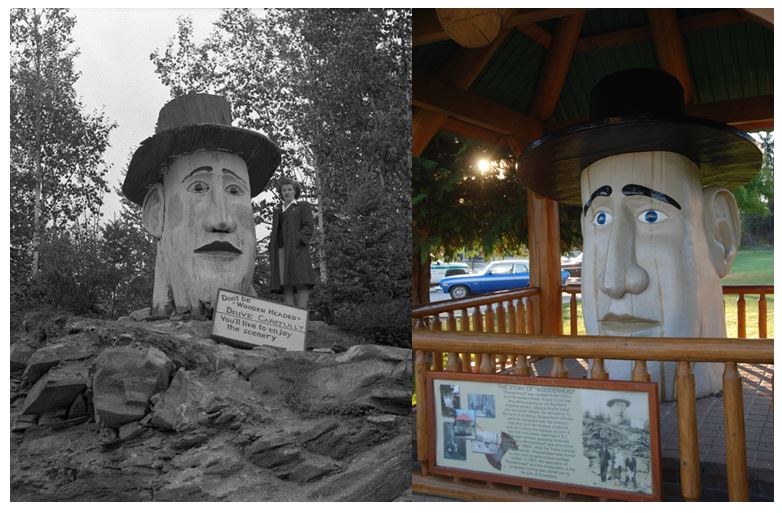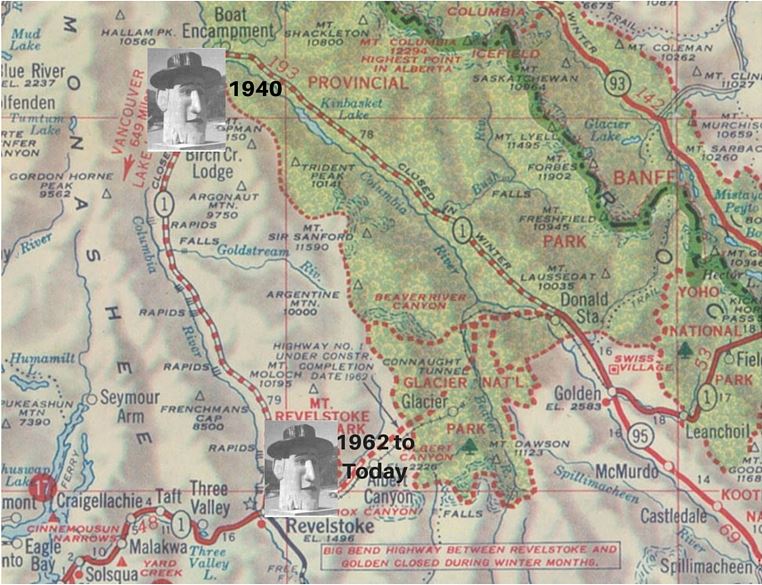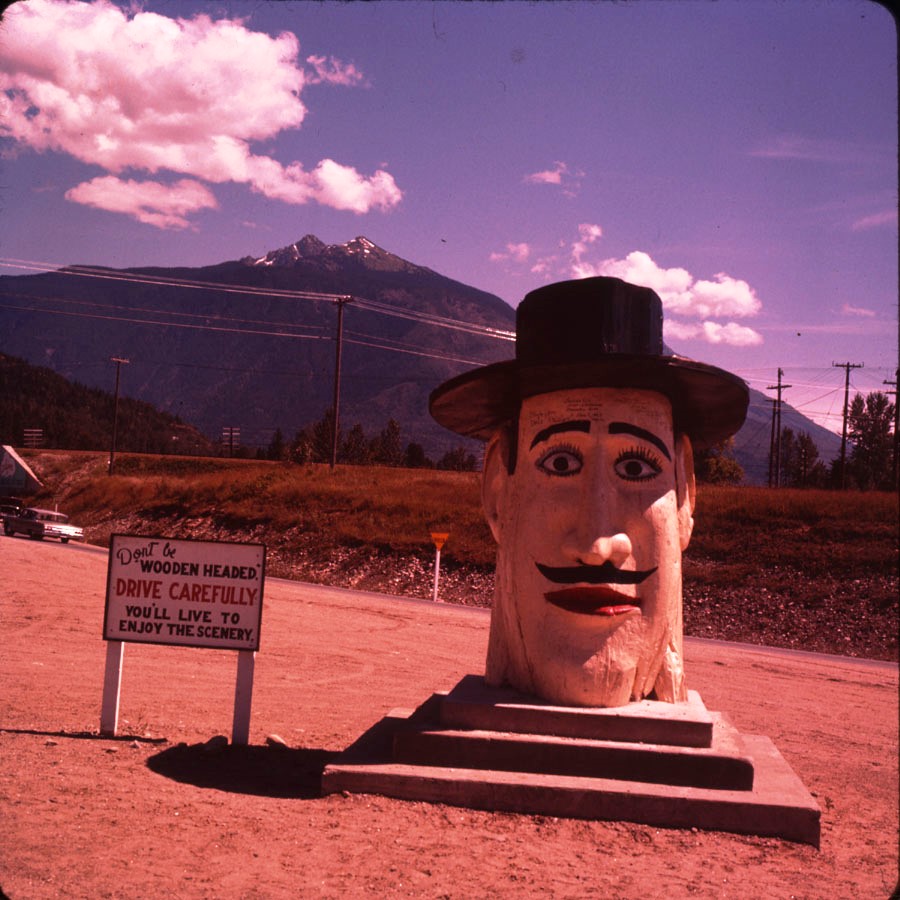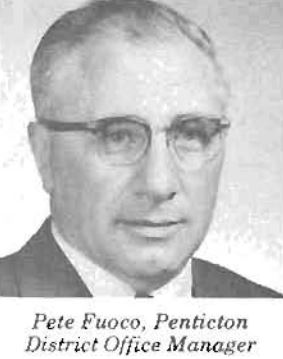
A man with a wooden stare is watching over the Trans-Canada Highway at Revelstoke, to see if motorists are driving safely.
The man, with his unblinking gaze, was once stationed along the Big Bend Highway and now resides in a park, named in his honour.
Just who is this man? Why it’s Woodenhead – BC’s highly original roadside attraction that started as a cedar stump!
Where Woodenhead Started
In the 1940s, a large stump was spotted by Peter Fuoco who was working as a timekeeper and first aid attendant for the federal government, on construction of the Big Bend Highway. Peter saw a resemblance to human facial features on the stump, and for something to do after hours at the tent camp, he shaped the wood into an oversized man’s head, using a double-bitted axe and a chisel.
Peter thought that his creation – which he says was not intended to be “a classical piece of sculpture” – would stay rooted. He was surprised when he was asked by a supervising engineer, to free Woodenhead from his attachment to the earth. Woodenhead was then sawed off, and trucked to “the big bend” of the thus-named highway, at Boat Encampment. The Big Bend Highway was an in-road to minerals and timber which travellers followed north, along the east side of the Columbia River, to Boat Encampment, then headed right back south toward Golden.
When the Big Bend Highway opened, in June 29, 1940, Woodenhead presided over the grand opening. He stood as one of BC’s first highway safety warning symbols, not be blockheaded, thick-skulled or well… woodenheaded. A sign mounted by the creation advised, “Don’t Be Wooden Headed. Drive Carefully. You’ll live to enjoy the scenery”

For the next 20 years, Woodenhead fixed his solid sights on the Big Bend Highway, where he warned and amused many a traveller. He was even featured on his own postcard.
Woodenhead on the Move
When the Roger’s Pass section of the Trans-Canada Highway opened in 1962, there was much more traffic travelling the more direct route, so Woodenhead was relocated to Revelstoke. Eventually he became a heritage artifact, and in 2005, the City of Revelstoke restored Woodenhead and built a sheltering roof over his head. In the meantime, the Big Bend Highway became an in-and-out route (now Highway 23), when parts of the route were flooded for the construction of hydro-electric dams.

Today, Woodenhead continues his unflinching scrutiny of Trans-Canada Highway motorists, still standing as a reminder to slow down and drive with care. From his home in Woodenhead Park, he fittingly oversaw the official proceedings for the 50th Anniversary of the Trans-Canada Highway celebration in 2012. (He might even have cracked a smile, if you watched extremely close.)

His creator, Peter Fuoco, went onto a career with the provincial Department of Highways and Public Works (our name back then), until his retirement in 1976, as the office manager for the Penticton District.
It took Peter’s creative mind and about six weeks of work to carve Woodenhead. What started as a pastime became a quirky and unique part of BC history, by a man destined to devote himself to the safe operation of highways in our province.
Have you met Woodenhead in your travels?
Thanks to Cathy English, curator at the Revelstoke Museum & Archives, for her helpfulness.
Woodenhead was carved in 1940 by my uncle Peter Fuoco. I have many pictures and articles about Woodenhead from his creation(1940) and his journey down the Big Bend Highway to Revelstoke , his repairs and “touchups” and several relocations until he was placed in his present home(2020) in Woodenhead Park in Revelstoke. Thank you for this article. I will add it to my collection .
Hello Rosemary – how wonderful to hear this! Thank you for sharing 🙂
Maybe there need to to be some duplicates at some of the common accident locations on the highway. You could start with 19 mile, Three Valley hill, Silver Creek, the first curve at the top of Albert Canyon hill etc. etc. (it might be easier just to put one one each km that hasn’t been upgraded yet.)
Thank you for your suggestions Nick!
Before Boat Encampment was *the* place on the No. 1 Big Bend Hwy., it was – from January 1811 to about 1850 – *the* place on the ‘north west passage’ for the fur trade and Hudson Bay company administration of the Columbia District (which included most of Washington and Oregon). The “York Factory Express” and/or “Columbia Express” was well travelled. Even then Woodenhead’s warning fit all to well – as in the tragic and dark, dark doings at the Dalles Des Mort -… just downstream.
Hi Grainger,
Thanks for your fascinating information about Boat Encampment when it was a central point for the fur trade on the Columbia River. Yes, the Dalles des Mort (Death Rapids) would have made travel on the river a challenging and possibly hair-raising journey, as noted on Wikipedia: https://en.wikipedia.org/wiki/Dalles_des_Morts I’m not sure that even Woodenhead’s warnings could have helped those who lost their lives there.
what is with the cheesy mustache and lip stick and eyelashes!! he is a guy right
and a good looking one at that!
I have a picture from the 50’s of my dad and my sister and I with the head on the Big Bend Hwy. Great to see the article and that the head is still around.
Awe – sounds like a great pic Lynn – thanks for sharing that with us!
I always love reading these types of posts and getting more insight into the history. I remember the Woodenhead from my youth when the family would travel from the South Okanagan to my grandparents place in Saskatchewan. The stories behind the old attractions we see along the highways are great to hear. Woodenhead as well as what I know as the Garbage Gobbler highway garbage cans, the cigarette hanging on the Hope-Princeton highway etc are all great childhood memories from our family car trips.
So glad to hear you remember these icons of BC highway history Brian. You might like our Road Trip Time Machine videos as well. All filmed by the ministry in 1966: https://www.youtube.com/playlist?list=PLKHNpQ_j-IWG8CG_KN7cwl5mMO2bz2x8w
I was privileged to have Peter Fuoco as a friend when he lived in Penticton. He was a kind, generous and humble man who would be so pleased to know that ‘Woodenhead’ still exists and that his story has not been forgotten. Thank you for this wonderful tribute!
Thank you for connecting with us here Susan and sharing this with us! We like to think he would be pleased too!
My family and I travelled the Big Bend Highway in 1960. We camped overnight at Kinbasket Lake, and I think I still have a photo of Woodenhead somewhere. I’ll never forget that trip. We returned to the prairies via the U.S. to Yahk B.C. then hwy 3 to Medicine Hat.
Thanks for sharing your memories of Woodenhead and camping in BC in 1960, with us.
Indeed I have.